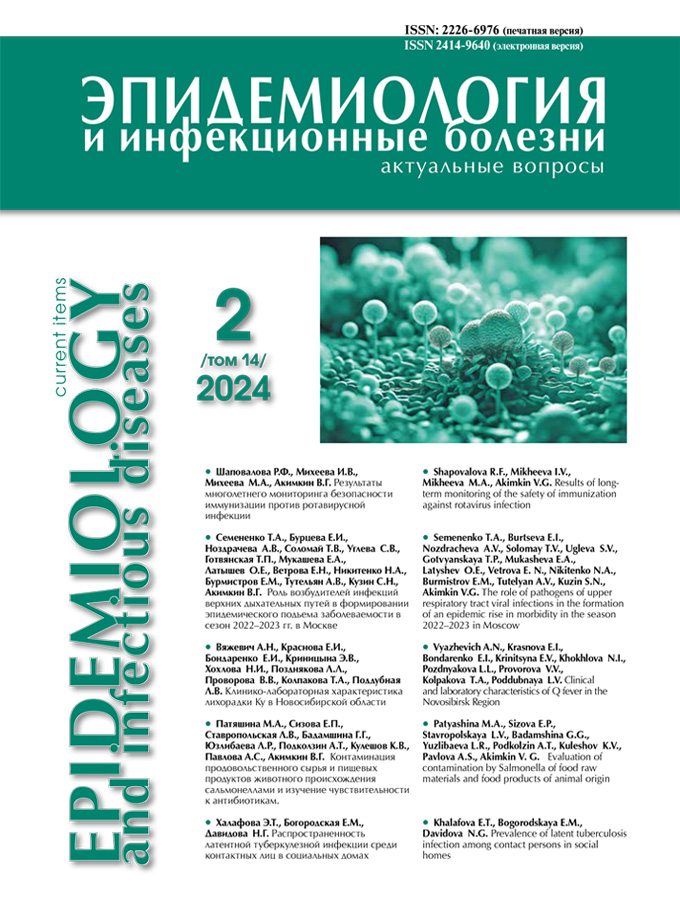«Masks» of Crimean hemorrhagic fever in medical practice
- 作者: Abuova G.N.1, Pshenichnaya N.Y.2,3, Lizinfeld I.A.2, Berdalieva F.A.1, Sadykhova D.K.1, Buharbayev B.B.1
-
隶属关系:
- South Kazakhstan Medical Academy
- Central Research Institute of Epidemiology, Russian Federal Service for Supervision of Consumer Rights Protection and Human Well-Being
- M.F. Vladimirsky Moscow Regional Research Clinical Institute named after
- 期: 卷 14, 编号 2 (2024)
- 页面: 87-93
- 栏目: Exchange of Experience
- URL: https://journals.eco-vector.com/2226-6976/article/view/635140
- DOI: https://doi.org/10.18565/epidem.2024.14.2.87-93
- ID: 635140
如何引用文章
详细
The severity and outcomes of Crimean hemorrhagic fever (CHF) depend on the timeliness of diagnosis and hospitalization in an infectious diseases hospital. Delay in diagnosis and initiation of specific treatment is an important risk factor for poor outcome.
Objective. Analysis of defects in the diagnosis of CHF and development on this basis of a differential diagnostic algorithm with an assessment of its effectiveness.
Materials and methods. A retrospective longitudinal study analyzed 94 laboratory-confirmed cases of CHF in patients who were admitted in infectious diseases hospitals in the Turkestan region and the city of Shymkent for 2011–2023.
Results. Difficulties in making a diagnosis of CHF were associated with the nonspecificity of symptoms at the initial stage of the disease, incomplete collection of anamnesis and epidemiological data, limited knowledge of medical personnel about the disease and the criteria for its diagnosis, and underestimation of the severity of the patient’s condition. Infectious, surgical, therapeutic and gynecological «masks» of CHF were established, and relevant clinical observations were presented. Analysis of cases of delayed diagnosis of CHF became the basis for the development of a differential diagnostic algorithm for this disease.
Conclusion. In natural foci of CHF, it is important for doctors of different professions to be vigilant, have up-to-date knowledge and apply modern diagnostic methods to reduce the likelihood of diagnostic errors when identifying CHF. Algorithms for the differential diagnosis of CHF created and applied in the training of medical workers led to a significant reduction in the proportion of cases of underestimation of CHF by 3.6 times and allowed to avoid delays in starting etiotropic and pathogenetic therapy.
全文:
作者简介
Gulzhan Abuova
South Kazakhstan Medical Academy
编辑信件的主要联系方式.
Email: dr.abuova@gmail.com
ORCID iD: 0000-0002-1210-2018
Professor, Cand. Med. Sci., Head, Department of Infectious Diseases and Dermatovenerology
哈萨克斯坦, ShymkentNatalia Pshenichnaya
Central Research Institute of Epidemiology, Russian Federal Service for Supervision of Consumer Rights Protection and Human Well-Being; M.F. Vladimirsky Moscow Regional Research Clinical Institute named after
Email: natalia-pshenichnaya@yandex.ru
ORCID iD: 0000-0003-2570-711X
Professor, MD, Deputy Director for Сlinical and Analytical Work, Professor, Department of Infectious Diseases
俄罗斯联邦, Moscow; MoscowIrina Lizinfeld
Central Research Institute of Epidemiology, Russian Federal Service for Supervision of Consumer Rights Protection and Human Well-Being
Email: irinalizinfeld@gmail.com
ORCID iD: 0000-0002-8114-1002
Cand. Med. Sci., Consultant
俄罗斯联邦, MoscowFarida Berdalieva
South Kazakhstan Medical Academy
Email: fberdalieva@mail.ru
ORCID iD: 0000-0001-9680-1678
PhD, Associate Professor, Department of Infectious Diseases and Dermatovenereology
哈萨克斯坦, ShymkentDana Sadykhova
South Kazakhstan Medical Academy
Email: danoka.kz@mail.ru
Assistant, Department of Infectious Diseases and Dermatovenereology
哈萨克斯坦, ShymkentB. Buharbayev
South Kazakhstan Medical Academy
Email: kz__erkin@mail.ru
ORCID iD: 0000-0003-2089-5393
Assistant, Department of Infectious Diseases and Dermatovenereology
哈萨克斯坦, Shymkent参考
- Nurmakhanov T., Sansyzbaev Y., Atshabar B., Deryabin P., Kazakov S., Zholshorinov A.et al. CrimeanCongo haemorrhagic fever virus in Kazakhstan (1948–2013). Int. J. Infect. Dis. 2015; 38: 19–23. DOI: 10.1016/j. ijid.2015.07.007
- Турлиев З.С., Усатаева Г.М. Эпидемиологическая ситуация в Республике Казахстан по Конго-Крымской геморрагической лихорадке. Вестник Казахского Национального медицинского университета 2019; (2): 20–3. Turliev Z.S., Usataeva G.M. [Epidemiological situation in the Republic of Kazakhstan regarding Congo-Crimean hemorrhagic fever]. Bulletin of the Kazakh National Medical University 2019; (2): 20–3. (In Russ.).
- Абуова Г.Н., Акимжанова Е.А., Жайыкбаева Ж.Т., Жабикенова Г.Д., Сейтханова Б.Т. Состояние проблемы диагностики и лечения Конго-Крымской геморрагической лихорадки в Южном Казахстане: достижения и перспективы: Материалы V Ежегодного Всероссийского конгресса по инфекционным болезням. М., 2016: 6–7. Abuova G.N., Akimzhanova E.A., Zhaiykbaeva Zh.T., Zhabikenova G.D., Seithanova B.T. [The state of the problem of diagnosis and treatment of Congo-Crimean hemorrhagic fever in South Kazakhstan: achievements and prospects: Abstracts of V Annual All-Russian Congress on Infectious Diseases]. Moscow. 2016: 6–7. (In Russ.).
- Егембердиева Р.А., Шерметова М.Б. Описание подтвержденного и вероятных случаев Крымской-Конго геморрагической лихорадки в Туркестанском районе Южно-Казахстанской области в 2007 году. Байкальский медицинский журнал 2008; 82(7): 131–3. Egemberdieva R.A., Shermetova M.B. [Description of confirmed and probable cases of Crimean-Congo hemorrhagic fever in the Turkestan region of the South Kazakhstan region in 2007]. Baikal Medical Journal 2008; 82(7): 131–3. (In Russ.).
- Сержанов М.О. Конго-Крымская геморрагическая лихорадка: случаи из практики. Вестник КазНМУ 2014; (1): 32–6. Serzhanov M.O.. [Congo-Crimean hemorrhagic fever: cases from practice]. Bulletin of the Kazan National Medical University 2014; (1): 32–6. (In Russ.).
- Онищенко Г.Г., Куличенко А.Н. (ред.). Крымская геморрагическая лихорадка. Воронеж: Фаворит, 2018. 288 с. Onishchenko G.G.. Kulichenko A.N. (eds.). [Crimean hemorrhagic fever]. Voronezh: Favorit, 2018. 288 p. (In Russ.).
- Конго-Крымская лихорадка: Клинический протокол диагностики лечения Министерства здравоохранения и социального развития Республики Казахстан от 12.12.2014. № 9. https://online.zakon.kz/ Document/?doc_id=39136838 [Clinical Protocol of diagnosis and treatment «Congo-Crimean fever». Guidelines of Ministry of Health and Social Development of Republic of Kazakhstan, 12.12.2014 № 9]. (In Russ.). https:// online.zakon.kz/Document/?doc_id=39136838
- Leblebicioglu H., Sunbul M., Guner R., Bodur H., Bulut C., Duygu F. et al. Healthcare-associated Crimean-Congo haemorrhagic fever in Turkey, 2002–2014: a multicentre retrospective cross-sectional study. Clin. Microbiol. Infect. 2016; 22(4): 387–e1. doi: 10.1016/j.cmi.2015.11.024
- Leblebicioglu H., Bodur H., Dokuzoguz B., Elaldi N., Guner R., Koksal I. et al. Case management and supportive treatment for patients with Crimean-Congo hemorrhagic fever. Vector-Borne and Zoonotic Diseases 2012; 12(9): 805–11. doi: 10.1089/vbz.2011.0896
- Mardani M., Jahromi M.K.., Naieni KH., Zeinali M. The efficacy of oral ribavirin in the treatment of Crimean-Congo hemorrhagic fever in Iran. Clin. Infect. Dis. 2003; 36(12): 1613–8. doi: 10.1086/375058
- Шарапов М.Б. Крымская-Конго геморрагическая лихорадка: Клиническое практическое руководство. Ташкент: MASHHUR PRESS, 2018. 352 с. Sharapov M.B. [Crimean-Congo hemorrhagic fever: A clinical practical guide]. Tashkent: MASHHUR PRESS, 2018. 352 p. (In Russ.).










